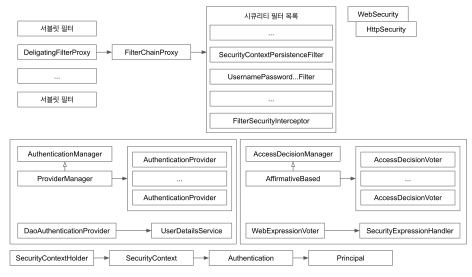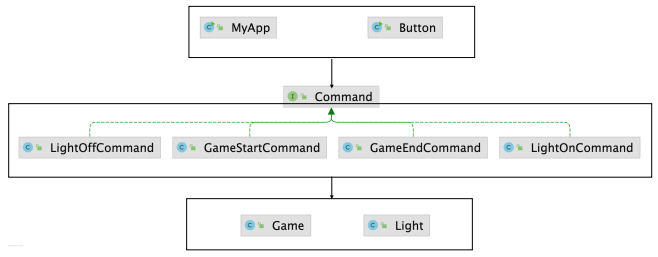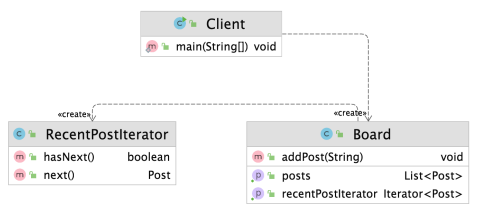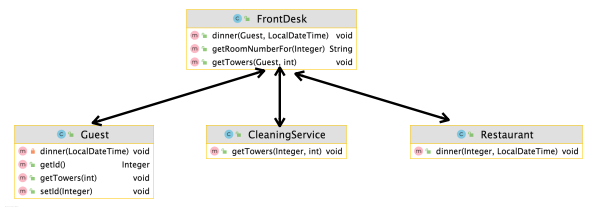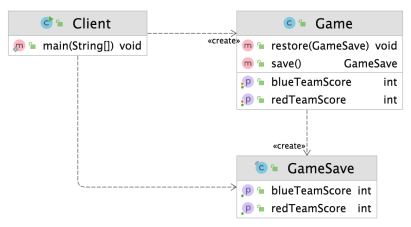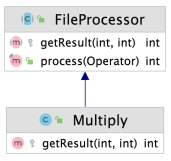코딩으로 학습하는 GoF의 디자인 패턴
행동 관련 패턴(Behavioral Patterns)
카테고리 : 코딩으로 학습하는 GoF의 디자인 패턴
행동 관련 패턴(Behavioral Patterns)
- 행동 관련 패턴(Behavioral Patterns)
책임 연쇄 패턴 (Chain-of-Responsibility) 패턴
요청을 보내는 쪽(sender)과 요청을 처리하는 쪽(receiver)의 분리하는 패턴
- 핸들러 체인을 사용해서 요청을 처리한다.
- 단일 책임 원칙에서의 책임
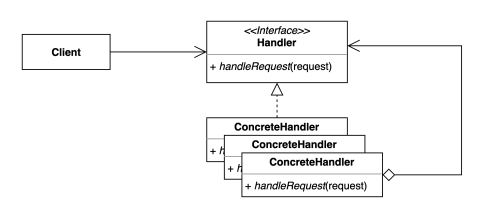
책임 연쇄 패턴 (Chain-of-Responsibility) 패턴 구현 방법
기존
- Request.class
public class Request {
private String body;
public Request(String body) {
this.body = body;
}
public String getBody() {
return body;
}
public void setBody(String body) {
this.body = body;
}
}
- RequestHandler.class
public class RequestHandler {
public void handler(Request request) {
System.out.println(request.getBody());
}
}
- AuthRequestHandler.class
public class AuthRequestHandler extends RequestHandler {
public void handler(Request request) {
System.out.println("인증이 되었나?");
System.out.println("이 핸들러를 사용할 수 있는 유저인가?");
super.handler(request);
}
}
- LoggingRequestHandler.class
public class LoggingRequestHandler extends RequestHandler {
@Override
public void handler(Request request) {
System.out.println("로깅");
super.handler(request);
}
}
- Client.class
public class Client {
public static void main(String[] args) {
Request request = new Request("무궁화 꽃이 피었습니다.");
RequestHandler requestHandler = new LoggingRequestHandler();
requestHandler.handler(request);
}
}
변경
- RequestHandler.class
public abstract class RequestHandler {
private RequestHandler nextHandler;
public RequestHandler(RequestHandler nextHandler) {
this.nextHandler = nextHandler;
}
public void handle(Request request) {
if (nextHandler != null) {
nextHandler.handle(request);
}
}
}
- PrintRequestHandler.class
public class PrintRequestHandler extends RequestHandler {
public PrintRequestHandler(RequestHandler nextHandler) {
super(nextHandler);
}
@Override
public void handle(Request request) {
System.out.println(request.getBody());
super.handle(request);
}
}
- LoggingRequestHandler.class
public class LoggingRequestHandler extends RequestHandler {
public LoggingRequestHandler(RequestHandler nextHandler) {
super(nextHandler);
}
@Override
public void handle(Request request) {
System.out.println("로깅");
super.handle(request);
}
}
- AuthRequestHandler.class
public class AuthRequestHandler extends RequestHandler {
public AuthRequestHandler(RequestHandler nextHandler) {
super(nextHandler);
}
@Override
public void handle(Request request) {
System.out.println("인증이 되었는가?");
super.handle(request);
}
}
- Client.class
public class Client {
private RequestHandler requestHandler;
public Client(RequestHandler requestHandler) {
this.requestHandler = requestHandler;
}
public void doWork() {
Request request = new Request("이번 놀이는 뽑기입니다.");
requestHandler.handle(request);
}
public static void main(String[] args) {
RequestHandler chain = new AuthRequestHandler(new LoggingRequestHandler(new PrintRequestHandler(null)));
Client client = new Client(chain);
client.doWork();
}
}
책임 연쇄 패턴 (Chain-of-Responsibility) 패턴 구현 복습
- 장점
- 클라이언트 코드를 변경하지 않고 새로운 핸들러를 체인에 추가할 수 있다.
- 각각의 체인은 자신이 해야하는 일만 한다.
- 체인을 다양한 방법으로 구성할 수 있다.
- 단점
- 디버깅이 조금 어렵다.
실무에서 어떻게 쓰이나?
- 자바
- 서블릿 필터
public class CoRInJava {
public static void main(String[] args) {
Filter filter = new Filter() {
@Override
public void doFilter(ServletRequest request, ServletResponse response, FilterChain chain) throws IOException, ServletException {
// TODO 전처리
chain.doFilter(request, response);
// TODO 후처리
}
};
}
}
@WebFilter(urlPatterns = "/hello")
public class MyFilter implements Filter {
@Override
public void doFilter(ServletRequest request, ServletResponse response, FilterChain chain) throws IOException, ServletException {
System.out.println("게임에 참하신 여러분 모두 진심으로 환영합니다.");
chain.doFilter(request, response);
System.out.println("꽝!");
}
}
@ServletComponentScan
@SpringBootApplication
public class App {
public static void main(String[] args) {
SpringApplication.run(App.class, args);
}
}
@RestController
public class HelloController {
@GetMapping("/hello")
public String hello() {
return "hello";
}
}
- 스프링
- 스프링 시큐리티 필터
@Configuration
public class SecurityConfig extends WebSecurityConfigurerAdapter {
@Override
protected void configure(HttpSecurity http) throws Exception {
http.authorizeRequests().anyRequest().permitAll().and();
}
}
커맨드 (Command) 패턴
요청을 캡슐화 하여 호출자(invoker)와 수신자(receiver)를 분리하는 패턴.
- 요청을 처리하는 방법이 바뀌더라도, 호출자의 코드는 변경되지 않는다.
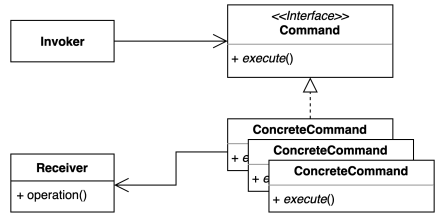
커맨드 (Command) 패턴 구현 방법
기존
- Light.class
public class Light {
private boolean isOn;
public void on() {
System.out.println("불을 켭니다.");
this.isOn = true;
}
public void off() {
System.out.println("불을 끕니다.");
this.isOn = false;
}
public boolean isOn() {
return this.isOn;
}
}
- Game.class
public class Game {
private boolean isStarted;
public void start() {
System.out.println("게임을 시작합니다.");
this.isStarted = true;
}
public void end() {
System.out.println("게임을 종료합니다.");
this.isStarted = false;
}
public boolean isStarted() {
return isStarted;
}
}
- Button.class
public class Button {
private Light light;
public Button(Light light) {
this.light = light;
}
public void press() {
light.off();
}
public static void main(String[] args) {
Button button = new Button(new Light());
button.press();
button.press();
button.press();
button.press();
}
}
- MyApp.class
public class MyApp {
private Game game;
public MyApp(Game game) {
this.game = game;
}
public void press() {
game.start();
}
public static void main(String[] args) {
Button button = new Button(new Light());
button.press();
button.press();
button.press();
button.press();
}
}
변경
- Command.class
public interface Command {
void execute();
void undo();
}
- GameEndCommand.class
public class GameEndCommand implements Command {
private Game game;
public GameEndCommand(Game game) {
this.game = game;
}
@Override
public void execute() {
game.end();
}
@Override
public void undo() {
new GameStartCommand(this.game).execute();
}
}
- GameStartCommand.class
public class GameStartCommand implements Command {
private Game game;
public GameStartCommand(Game game) {
this.game = game;
}
@Override
public void execute() {
game.start();
}
@Override
public void undo() {
new GameEndCommand(this.game).execute();
}
}
- LightOffCommand.class
public class LightOffCommand implements Command {
private Light light;
public LightOffCommand(Light light) {
this.light = light;
}
@Override
public void execute() {
light.off();
}
@Override
public void undo() {
new LightOnCommand(this.light).execute();
}
}
- LightOnCommand.class
public class LightOnCommand implements Command {
private Light light;
public LightOnCommand(Light light) {
this.light = light;
}
@Override
public void execute() {
light.on();
}
@Override
public void undo() {
new LightOffCommand(this.light).execute();
}
}
- Button.class
public class Button {
private Stack<Command> commands = new Stack<>();
public void press(Command command) {
command.execute();
commands.push(command);
}
public void undo() {
if (!commands.isEmpty()) {
Command command = commands.pop();
command.undo();
}
}
public static void main(String[] args) {
Button button = new Button();
button.press(new GameStartCommand(new Game()));
button.press(new LightOnCommand(new Light()));
button.undo();
button.undo();
}
}
- MyApp.class
public class MyApp {
private Command command;
public MyApp(Command command) {
this.command = command;
}
public void press() {
command.execute();
}
public static void main(String[] args) {
MyApp myApp = new MyApp(new GameStartCommand(new Game()));
}
}
커맨드 (Command) 패턴 구현 복습
- 장점
- 기존의 코드를 변경하지 않고 새로운 커맨드를 만들 수 있다.
- 수신자의 코드가 변경되어도 호출자의 코드는 변경되지 않는다.
- 커맨드 객체를 로깅, DB에 저장, 네트워크로 전송 하는 등 당양한 방법으로 활용할 수도 있다.
- 단점
- 코드가 복잡하고 클래스가 많아진다.
실무에서 어떻게 쓰이나?
- 자바
- Runnable
- 람다
- 메소드 레퍼런스
public class CommandInJava {
public static void main(String[] args) {
Light light = new Light();
Game game = new Game();
ExecutorService executorService = Executors.newFixedThreadPool(4);
executorService.submit(light::on);
executorService.submit(game::start);
executorService.submit(game::end);
executorService.submit(light::off);
executorService.shutdown();
}
}
- 스프링
- SimpleJdbcInsert
- SimpleJdbcCall
public class CommandInSpring {
private DataSource dataSource;
public CommandInSpring(DataSource dataSource) {
this.dataSource = dataSource;
}
public void add(Command command) {
SimpleJdbcInsert insert = new SimpleJdbcInsert(dataSource)
.withTableName("command")
.usingGeneratedKeyColumns("id");
Map<String, Object> data = new HashMap<>();
data.put("name", command.getClass().getSimpleName());
data.put("when", LocalDateTime.now());
insert.execute(data);
}
}
인터프리터 (Interpreter) 패턴
자주 등장하는 문제를 간단한 언어로 정의하고 재사용하는 패턴
- 반복되는 문제 패턴을 언어 또는 문법으로 정의하고 확장할 수 있다.
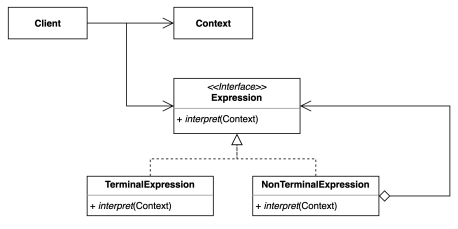
인터프리터 (Interpreter) 패턴 구현 방법
기존
- PostfixNotation.class
public class PostfixNotation {
private final String expression;
public PostfixNotation(String expression) {
this.expression = expression;
}
public static void main(String[] args) {
PostfixNotation postfixNotation = new PostfixNotation("123+-");
postfixNotation.calculate();
}
private void calculate() {
Stack<Integer> numbers = new Stack<>();
for (char c : this.expression.toCharArray()) {
switch (c) {
case '+':
numbers.push(numbers.pop() + numbers.pop());
break;
case '-':
int right = numbers.pop();
int left = numbers.pop();
numbers.push(left - right);
break;
default:
numbers.push(Integer.parseInt(c + ""));
}
}
System.out.println(numbers.pop());
}
}
변경
__ 방법 1 __
- PostfixParser.class
public class PostfixParser {
public static PostfixExpression parse(String expression) {
Stack<PostfixExpression> stack = new Stack<>();
for (char c : expression.toCharArray()) {
stack.push(getExpression(c, stack));
}
return stack.pop();
}
private static PostfixExpression getExpression(char c, Stack<PostfixExpression> stack) {
switch (c) {
case '+':
return new PlusExpression(stack.pop(), stack.pop());
case '-':
PostfixExpression right = stack.pop();
PostfixExpression left = stack.pop();
return new MinusExpression(left, right);
default:
return new VariableExpression(c);
}
}
}
- PostfixExpression.class
public interface PostfixExpression {
int interpret(Map<Character, Integer> context);
}
- VariableExpression.class
public class VariableExpression implements PostfixExpression {
private Character character;
public VariableExpression(Character character) {
this.character = character;
}
@Override
public int interpret(Map<Character, Integer> context) {
return context.get(this.character);
}
}
- PlusExpression.class
public class PlusExpression implements PostfixExpression {
private PostfixExpression left;
private PostfixExpression right;
public PlusExpression(PostfixExpression left, PostfixExpression right) {
this.left = left;
this.right = right;
}
@Override
public int interpret(Map<Character, Integer> context) {
return left.interpret(context) + right.interpret(context);
}
}
- MinusExpression.class
public class MinusExpression implements PostfixExpression {
private PostfixExpression left;
private PostfixExpression right;
public MinusExpression(PostfixExpression left, PostfixExpression right) {
this.left = left;
this.right = right;
}
@Override
public int interpret(Map<Character, Integer> context) {
return left.interpret(context) - right.interpret(context);
}
}
- MultiplyExpression.class
public class MultiplyExpression implements PostfixExpression{
private PostfixExpression left, right;
public MultiplyExpression(PostfixExpression left, PostfixExpression right) {
this.left = left;
this.right = right;
}
@Override
public int interpret(Map<Character, Integer> context) {
return left.interpret(context) * right.interpret(context);
}
}
- App.class
public class App {
public static void main(String[] args) {
PostfixExpression expression = PostfixParser.parse("xyz+-a+");
int result = expression.interpret(Map.of('x', 1, 'y', 2, 'z', 3, 'a', 4));
System.out.println(result);
}
}
방법2
- PostfixExpression.class
public interface PostfixExpression {
int interpret(Map<Character, Integer> context);
static PostfixExpression plus(PostfixExpression left, PostfixExpression right){
return context -> left.interpret(context) + right.interpret(context);
}
static PostfixExpression minus(PostfixExpression left, PostfixExpression right){
return context -> left.interpret(context) - right.interpret(context);
}
static PostfixExpression variable(Character c){
return context -> context.get(c);
}
}
- PostfixParser.class
public class PostfixParser {
public static PostfixExpression parse(String expression) {
Stack<PostfixExpression> stack = new Stack<>();
for (char c : expression.toCharArray()) {
stack.push(getExpression(c, stack));
}
return stack.pop();
}
private static PostfixExpression getExpression(char c, Stack<PostfixExpression> stack) {
switch (c) {
case '+':
return PostfixExpression.plus(stack.pop(), stack.pop());
case '-':
PostfixExpression right = stack.pop();
PostfixExpression left = stack.pop();
return PostfixExpression.minus(left, right);
default:
return PostfixExpression.variable(c);
}
}
}
인터프리터 (Interpreter) 패턴 구현 복습
- 장점
- 자주 등장하는 문제 패턴을 언어와 문법으로 정의할 수 있다.
- 기존 코드를 변경하지 않고 새로운 Expression을 추가 할 수 있다.
- 단점
- 복잡한 문법을 표현하려면 Expression와 Parser가 복잡해진다.
실무에서 어떻게 쓰이나?
- 자바
- 자바 컴파일러
- 정규 표현식
public class InterpreterInJava {
public static void main(String[] args) {
System.out.println(Pattern.matches(".pr...", "spring"));
System.out.println(Pattern.matches("[a-z]{6}", "spring"));
System.out.println(Pattern.matches("white[a-z]{4}[0-9]{4}", "whiteship2000"));
System.out.println(Pattern.matches("\\d", "1")); // one digit
System.out.println(Pattern.matches("\\D", "a")); // one non-digit
}
}
- 스프링
- SpEL(스프링 Expression Language)
public class InterpreterInSpring {
public static void main(String[] args) {
Book book = new Book("spring");
ExpressionParser parser = new SpelExpressionParser();
Expression expression = parser.parseExpression("title");
System.out.println(expression.getValue(book));
}
}
@Service
public class MyService implements ApplicationRunner {
@Value("#{2 + 5}")
private String value;
@Override
public void run(ApplicationArguments args) throws Exception {
System.out.println(value);
}
}
이터레이터 (Interator) 패턴
집합 객체 내부 구조를 노출시키지 않고 순회하는 방법을 제공하는 패턴
- 집합 객체를 순회하는 클라이언트 코드를 변경하지 않고 다양한 순회 방법을 제공할 수 있다.
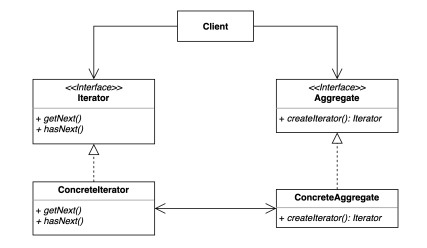
이터레이터 (Interator) 패턴 구현 방법
기존
- Post.class
public class Post {
private String title;
private LocalDateTime createdDateTime;
public Post(String title) {
this.title = title;
this.createdDateTime = LocalDateTime.now();
}
public String getTitle() {
return title;
}
public void setTitle(String title) {
this.title = title;
}
public LocalDateTime getCreatedDateTime() {
return createdDateTime;
}
public void setCreatedDateTime(LocalDateTime createdDateTime) {
this.createdDateTime = createdDateTime;
}
}
- Board.class
public class Board {
List<Post> posts = new ArrayList<>();
public List<Post> getPosts() {
return posts;
}
public void setPosts(List<Post> posts) {
this.posts = posts;
}
public void addPost(String content) {
this.posts.add(new Post(content));
}
}
- Client.class
public class Client {
public static void main(String[] args) {
Board board = new Board();
board.addPost("디자인 패턴 게임");
board.addPost("선생님, 저랑 디자인 패턴 하나 학습하시겠습니까?");
board.addPost("지금 이 자리에 계신 여러분들은 모두 디자인 패턴을 학습하고 계신 분들입니다.");
// TODO 들어간 순서대로 순회하기
List<Post> posts = board.getPosts();
for (int i = 0 ; i < posts.size() ; i++) {
Post post = posts.get(i);
System.out.println(post.getTitle());
}
// TODO 가장 최신 글 먼저 순회하기
Collections.sort(posts, (p1, p2) -> p2.getCreatedDateTime().compareTo(p1.getCreatedDateTime()));
for (int i = 0 ; i < posts.size() ; i++) {
Post post = posts.get(i);
System.out.println(post.getTitle());
}
}
}
수정
- RecentPostIterator.class
public class RecentPostIterator implements Iterator<Post> {
private Iterator<Post> internalIterator;
public RecentPostIterator(List<Post> posts) {
Collections.sort(posts, (p1, p2) -> p2.getCreatedDateTime().compareTo(p1.getCreatedDateTime()));
this.internalIterator = posts.iterator();
}
@Override
public boolean hasNext() {
return this.internalIterator.hasNext();
}
@Override
public Post next() {
return this.internalIterator.next();
}
}
- Board.class
public class Board {
List<Post> posts = new ArrayList<>();
public List<Post> getPosts() {
return posts;
}
public void addPost(String content) {
this.posts.add(new Post(content));
}
public Iterator<Post> getRecentPostIterator() {
return new RecentPostIterator(this.posts);
}
}
- Client.class
public class Client {
public static void main(String[] args) {
Board board = new Board();
board.addPost("디자인 패턴 게임");
board.addPost("선생님, 저랑 디자인 패턴 하나 학습하시겠습니까?");
board.addPost("지금 이 자리에 계신 여러분들은 모두 디자인 패턴을 학습하고 계신 분들입니다.");
// TODO 들어간 순서대로 순회하기
List<Post> posts = board.getPosts();
Iterator<Post> iterator = posts.iterator();
System.out.println(iterator.getClass());
for (int i = 0 ; i < posts.size() ; i++) {
Post post = posts.get(i);
System.out.println(post.getTitle());
}
// TODO 가장 최신 글 먼저 순회하기
Iterator<Post> recentPostIterator = board.getRecentPostIterator();
while(recentPostIterator.hasNext()) {
System.out.println(recentPostIterator.next().getTitle());
}
}
}
이터레이터 (Interator) 패턴 구현 복습
- 장점
- 집합 객체가 가지고 있는 객체들에 손쉽게 접근할 수 있다.
- 일괄된 인터페이스를 사용해 여러 형태의 집합 구조를 순회할 수 있다.
- 단점
- 클래스가 늘어나고 복잡도가 증가한다.
실무에서 어떻게 쓰이나?
- 자바
- java.util.Enumeration과 java.util.Iterator
- Java StAX (Streaming API for XML)의 Iterator 기반 API
- XmlEventReader, XmlEventWriter
public class IteratorInJava {
public static void main(String[] args) throws FileNotFoundException, XMLStreamException {
Enumeration enumeration;
Iterator iterator;
Board board = new Board();
board.addPost("디자인 패턴 게임");
board.addPost("선생님, 저랑 디자인 패턴 하나 학습하시겠습니까?");
board.addPost("지금 이 자리에 계신 여러분들은 모두 디자인 패턴을 학습하고 계신 분들입니다.");
// board.getPosts().iterator().forEachRemaining(p -> System.out.println(p.getTitle()));
// TODO Streaming API for XML(StAX), 이터레이터 기반의 API
XMLInputFactory xmlInputFactory = XMLInputFactory.newInstance();
XMLEventReader reader = xmlInputFactory.createXMLEventReader(new FileInputStream("Book.xml"));
while (reader.hasNext()) {
XMLEvent nextEvent = reader.nextEvent();
if (nextEvent.isStartElement()) {
StartElement startElement = nextEvent.asStartElement();
QName name = startElement.getName();
if (name.getLocalPart().equals("book")) {
Attribute title = startElement.getAttributeByName(new QName("title"));
System.out.println(title.getValue());
}
}
}
}
}
- 스프링
- CompositeIterator
public class IteratorInSpring {
public static void main(String[] args) {
CompositeIterator iterator;
}
}
중재자 (Mediator) 패턴
여러 객체들이 소통하는 방법을 캡슐화하는 패턴
- 여러 컴포넌트간의 결합도를 중재자를 통해 낮출 수 있다.
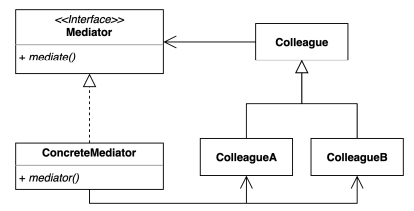
중재자 (Mediator) 패턴 구현 방법
기존
- Guest.class
public class Guest {
private Restaurant restaurant = new Restaurant();
private CleaningService cleaningService = new CleaningService();
public void dinner() {
restaurant.dinner(this);
}
public void getTower(int numberOfTower) {
cleaningService.getTower(this, numberOfTower);
}
}
- Gym.class
public class Gym {
private CleaningService cleaningService;
public void clean() {
cleaningService.clean(this);
}
}
- Restaurant.class
public class Restaurant {
private CleaningService cleaningService = new CleaningService();
public void dinner(Guest guest) {
System.out.println("dinner " + guest);
}
public void clean() {
cleaningService.clean(this);
}
}
- CleaningService.class
public class CleaningService {
public void clean(Gym gym) {
System.out.println("clean " + gym);
}
public void getTower(Guest guest, int numberOfTower) {
System.out.println(numberOfTower + " towers to " + guest);
}
public void clean(Restaurant restaurant) {
System.out.println("clean " + restaurant);
}
}
- Hotel.class
public class Hotel {
public static void main(String[] args) {
Guest guest = new Guest();
guest.getTower(3);
guest.dinner();
Restaurant restaurant = new Restaurant();
restaurant.clean();
}
}
수정
- CleaningService.class
public class CleaningService {
private FrontDesk frontDesk = new FrontDesk();
public void getTowers(Integer guestId, int numberOfTowers) {
String roomNumber = this.frontDesk.getRoomNumberFor(guestId);
System.out.println("provide " + numberOfTowers + " to " + roomNumber);
}
}
- Guest.class
public class Guest {
private Integer id;
private FrontDesk frontDesk = new FrontDesk();
public void getTowers(int numberOfTowers) {
this.frontDesk.getTowers(this, numberOfTowers);
}
private void dinner(LocalDateTime dateTime) {
this.frontDesk.dinner(this, dateTime);
}
public Integer getId() {
return id;
}
public void setId(Integer id) {
this.id = id;
}
}
- Restaurant.class
public class Restaurant {
public void dinner(Integer id, LocalDateTime dateTime) {
}
}
- FrontDesk.class
public class FrontDesk {
private CleaningService cleaningService = new CleaningService();
private Restaurant restaurant = new Restaurant();
public void getTowers(Guest guest, int numberOfTowers) {
cleaningService.getTowers(guest.getId(), numberOfTowers);
}
public String getRoomNumberFor(Integer guestId) {
return "1111";
}
public void dinner(Guest guest, LocalDateTime dateTime) {
restaurant.dinner(guest.getId(), dateTime);
}
}
중재자 (Mediator) 패턴 구현 복습
- 장점
- 컴포넌트 코드를 변경하지 않고 새로운 중재자를 만들어 사용할 수 있다.
- 각각의 컴포넌트 코드를 보다 간결하게 유지할 수 있다.
- 단점
- 중재자 역할을 하는 클래스의 복잡도와 결합도가 증가한다.
실무에서 어떻게 쓰이나?
- 자바
- ExecutorService
- Executor
- 스프링
- DispatcherServlet
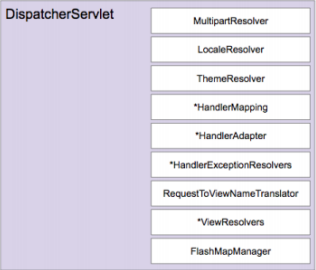
메멘토 (Memento) 패턴
캡슐화를 유지하면서 객체 내부 상태를 외부에 저장하는 방법.
- 객체 상태를 외부에 저장했다가 해당 상태로 다시 복구할 수 있다.
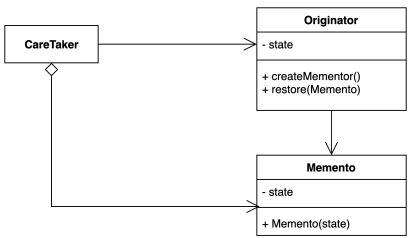
메멘토 (Memento) 패턴 구현 방법
기존
- Game.class
public class Game implements Serializable {
private int redTeamScore;
private int blueTeamScore;
public int getRedTeamScore() {
return redTeamScore;
}
public void setRedTeamScore(int redTeamScore) {
this.redTeamScore = redTeamScore;
}
public int getBlueTeamScore() {
return blueTeamScore;
}
public void setBlueTeamScore(int blueTeamScore) {
this.blueTeamScore = blueTeamScore;
}
}
- Client.class
public class Client {
public static void main(String[] args) {
Game game = new Game();
game.setRedTeamScore(10);
game.setBlueTeamScore(20);
int blueTeamScore = game.getBlueTeamScore();
int redTeamScore = game.getRedTeamScore();
Game restoredGame = new Game();
restoredGame.setBlueTeamScore(blueTeamScore);
restoredGame.setRedTeamScore(redTeamScore);
}
}
변경
- GameSave.class
public final class GameSave {
private final int blueTeamScore;
private final int redTeamScore;
public GameSave(int blueTeamScore, int redTeamScore) {
this.blueTeamScore = blueTeamScore;
this.redTeamScore = redTeamScore;
}
public int getBlueTeamScore() {
return blueTeamScore;
}
public int getRedTeamScore() {
return redTeamScore;
}
}
- Game.class
public class Game {
private int redTeamScore;
private int blueTeamScore;
public int getRedTeamScore() {
return redTeamScore;
}
public void setRedTeamScore(int redTeamScore) {
this.redTeamScore = redTeamScore;
}
public int getBlueTeamScore() {
return blueTeamScore;
}
public void setBlueTeamScore(int blueTeamScore) {
this.blueTeamScore = blueTeamScore;
}
public GameSave save() {
return new GameSave(this.blueTeamScore, this.redTeamScore);
}
public void restore(GameSave gameSave) {
this.blueTeamScore = gameSave.getBlueTeamScore();
this.redTeamScore = gameSave.getRedTeamScore();
}
}
- Clients.class
public class Client {
public static void main(String[] args) {
Game game = new Game();
game.setBlueTeamScore(10);
game.setRedTeamScore(20);
GameSave save = game.save();
game.setBlueTeamScore(12);
game.setRedTeamScore(22);
game.restore(save);
System.out.println(game.getBlueTeamScore());
System.out.println(game.getRedTeamScore());
}
}
메멘토 (Memento) 패턴 구현 복습
- 장점
- 캡슐화를 지키면서 상태 객체 상태 스냅샷을 만들 수 있다.
- 객체 상태 저장하고 또는 복원하는 역할을 CareTaker에게 위임할 수 있다.
- 객체 상태가 바뀌어도 클라이언트 코드는 변경되지 않는다.
- 단점
- 많은 정보를 저장하는 Memetor를 자주 생성하는 경우 메모리 사용량에 많은 역향을 줄 수 있다.
실무에서 어떻게 쓰이나?
- 자바
- 객체 직렬화, java.io.Serializable
- java.util.Date
public class MementoInJava {
public static void main(String[] args) throws IOException, ClassNotFoundException {
// TODO Serializable
Game game = new Game();
game.setRedTeamScore(10);
game.setBlueTeamScore(20);
// TODO 직렬화
try(FileOutputStream fileOut = new FileOutputStream("GameSave.hex");
ObjectOutputStream out = new ObjectOutputStream(fileOut))
{
out.writeObject(game);
}
game.setBlueTeamScore(25);
game.setRedTeamScore(15);
// TODO 역직렬화
try(FileInputStream fileIn = new FileInputStream("GameSave.hex");
ObjectInputStream in = new ObjectInputStream(fileIn))
{
game = (Game) in.readObject();
System.out.println(game.getBlueTeamScore());
System.out.println(game.getRedTeamScore());
}
}
}
옵저버 (Observer) 패턴
다수의 객체가 특정 객체 상태 변화를 감지하고 알림을 받는 패턴.
- 발행(publish)-구독(subscribe) 패턴을 구현할 수 있다.
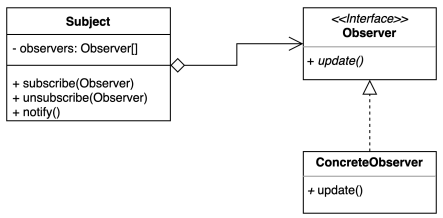
옵저버 (Observer) 패턴 구현 방법
기존
- ChatServer.class
public class ChatServer {
private Map<String, List<String>> messages;
public ChatServer() {
this.messages = new HashMap<>();
}
public void add(String subject, String message) {
if (messages.containsKey(subject)) {
messages.get(subject).add(message);
} else {
List<String> messageList = new ArrayList<>();
messageList.add(message);
messages.put(subject, messageList);
}
}
public List<String> getMessage(String subject) {
return messages.get(subject);
}
}
- User.class
public class User {
private ChatServer chatServer;
public User(ChatServer chatServer) {
this.chatServer = chatServer;
}
public void sendMessage(String subject, String message) {
chatServer.add(subject, message);
}
public List<String> getMessage(String subject) {
return chatServer.getMessage(subject);
}
}
- Client.class
public class Client {
public static void main(String[] args) {
ChatServer chatServer = new ChatServer();
User user1 = new User(chatServer);
user1.sendMessage("디자인패턴", "이번엔 옵저버 패턴입니다.");
user1.sendMessage("롤드컵2021", "LCK 화이팅!");
User user2 = new User(chatServer);
System.out.println(user2.getMessage("디자인패턴"));
user1.sendMessage("디자인패턴", "예제 코드 보는 중..");
System.out.println(user2.getMessage("디자인패턴"));
}
}
변경
- Subscriber.class
public interface Subscriber {
void handleMessage(String message);
}
- User.class
public class User implements Subscriber {
private String name;
public User(String name) {
this.name = name;
}
public String getName() {
return name;
}
@Override
public void handleMessage(String message) {
System.out.println(message);
}
}
- ChatServer.class
public class ChatServer {
private Map<String, List<Subscriber>> subscribers = new HashMap<>();
public void register(String subject, Subscriber subscriber) {
if (this.subscribers.containsKey(subject)) {
this.subscribers.get(subject).add(subscriber);
} else {
List<Subscriber> list = new ArrayList<>();
list.add(subscriber);
this.subscribers.put(subject, list);
}
}
public void unregister(String subject, Subscriber subscriber) {
if (this.subscribers.containsKey(subject)) {
this.subscribers.get(subject).remove(subscriber);
}
}
public void sendMessage(User user, String subject, String message) {
if (this.subscribers.containsKey(subject)) {
String userMessage = user.getName() + ": " + message;
this.subscribers.get(subject).forEach(s -> s.handleMessage(userMessage));
}
}
}
- Client.class
public class Client {
public static void main(String[] args) {
ChatServer chatServer = new ChatServer();
User user1 = new User("keesun");
User user2 = new User("whiteship");
chatServer.register("오징어게임", user1);
chatServer.register("오징어게임", user2);
chatServer.register("디자인패턴", user1);
chatServer.sendMessage(user1, "오징어게임", "아.. 이름이 기억났어.. 일남이야.. 오일남");
chatServer.sendMessage(user2, "디자인패턴", "옵저버 패턴으로 만든 채팅");
chatServer.unregister("디자인패턴", user2);
chatServer.sendMessage(user2, "디자인패턴", "옵저버 패턴 장, 단점 보는 중");
}
}
옵저버 (Observer) 패턴 구현 복습
- 장점
- 상태를 변경하는 객체(publisher)와 변경을 감지하는 객체(subscribe)의 관계를 느슨하게 유지할 수 있다.
- Subject의 상태 변경을 주기적으로 조회하지 않고 자동으로 감지할 수 있다.
- 런타임에 옵저버를 추가하거나 제거할 수 있다.
- 단점
- 복잡도가 증가한다.
- 다수의 Observer 객체를 등록 이후 해지 않는다면 memory leak이 발생할 수도 있다.
- WeakReference 를 활용 방안이 있다., 명시적으로 해지 하는게 최우선이다.
실무에서 어떻게 쓰이나?
- 자바
- Observable과 Observer (자바 9부터 deprecated)
- 자바 9 이후 부터는
- PropertyChangeListener, PropertyChangeEvent
- Flow API
- SAX (Simple API for XML) 라이브러리
public class ObserverInJava {
static class User implements Observer {
@Override
public void update(Observable o, Object arg) {
System.out.println(arg);
}
}
static class Subject extends Observable {
public void add(String message) {
setChanged();
notifyObservers(message);
}
}
public static void main(String[] args) {
Subject subject = new Subject();
User user = new User();
subject.addObserver(user);
subject.add("Hello Java, Observer");
}
}
public class PropertyChangeExample {
static class User implements PropertyChangeListener {
@Override
public void propertyChange(PropertyChangeEvent evt) {
System.out.println(evt.getNewValue());
}
}
static class Subject {
PropertyChangeSupport support = new PropertyChangeSupport(this);
public void addObserver(PropertyChangeListener observer) {
support.addPropertyChangeListener(observer);
}
public void removeObserver(PropertyChangeListener observer) {
support.removePropertyChangeListener(observer);
}
public void add(String message) {
support.firePropertyChange("eventName", null, message);
}
}
public static void main(String[] args) {
Subject subject = new Subject();
User observer = new User();
subject.addObserver(observer);
subject.add("자바 PCL 예제 코드");
subject.removeObserver(observer);
subject.add("이 메시지는 볼 수 없지..");
}
}
public class FlowInJava {
public static void main(String[] args) throws InterruptedException {
Flow.Publisher<String> publisher = new SubmissionPublisher<>();
Flow.Subscriber<String> subscriber = new Flow.Subscriber<String>() {
private Flow.Subscription subscription;
@Override
public void onSubscribe(Flow.Subscription subscription) {
System.out.println("sub!");
this.subscription = subscription;
this.subscription.request(1);
}
@Override
public void onNext(String item) {
System.out.println("onNext called");
System.out.println(Thread.currentThread().getName());
System.out.println(item);
}
@Override
public void onError(Throwable throwable) {
}
@Override
public void onComplete() {
System.out.println("completed");
}
};
publisher.subscribe(subscriber);
((SubmissionPublisher)publisher).submit("hello java");
System.out.println("이게 먼저 출력될 수도 있습니다.");
}
}
- 스프링
- ApplicationContext와 ApplicationEvent
public class MyEvent {
private String message;
public MyEvent(String message) {
this.message = message;
}
public String getMessage() {
return message;
}
}
@Component
public class MyEventListener {
@EventListener(MyEvent.class)
public void onApplicationEvent(MyEvent event) {
System.out.println(event.getMessage());
}
}
@Component
public class MyRunner implements ApplicationRunner {
private ApplicationEventPublisher publisher;
public MyRunner(ApplicationEventPublisher publisher) {
this.publisher = publisher;
}
@Override
public void run(ApplicationArguments args) throws Exception {
publisher.publishEvent(new MyEvent("hello spring event"));
}
}
상태 (State) 패턴
객체 내부 상태 변경에 따라 객체의 행동이 달라지는 패턴.
- 상태에 특화된 행동들을 분리해 낼 수 있으며, 새로운 행동이 추가하더라도 다른 행동에 영향을 주지 않는다.
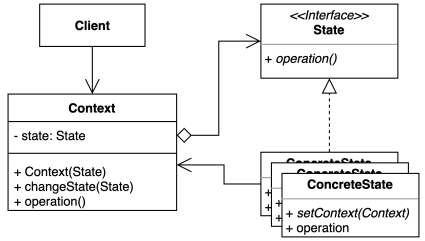
상태 (State) 패턴 구현 방법
기존
- Student.class
public class Student {
private String name;
public Student(String name) {
this.name = name;
}
private List<OnlineCourse> privateCourses = new ArrayList<>();
public boolean isEnabledForPrivateClass(OnlineCourse onlineCourse) {
return privateCourses.contains(onlineCourse);
}
public void addPrivateCourse(OnlineCourse onlineCourse) {
this.privateCourses.add(onlineCourse);
}
@Override
public String toString() {
return "Student{" +
"name='" + name + '\'' +
'}';
}
}
- OnlineCourse.class
public class OnlineCourse {
public enum State {
DRAFT, PUBLISHED, PRIVATE
}
private State state = State.DRAFT;
private List<String> reviews = new ArrayList<>();
private List<Student> students = new ArrayList<>();
public void addReview(String review, Student student) {
if (this.state == State.PUBLISHED) {
this.reviews.add(review);
} else if (this.state == State.PRIVATE && this.students.contains(student)) {
this.reviews.add(review);
} else {
throw new UnsupportedOperationException("리뷰를 작성할 수 없습니다.");
}
}
public void addStudent(Student student) {
if (this.state == State.DRAFT || this.state == State.PUBLISHED) {
this.students.add(student);
} else if (this.state == State.PRIVATE && availableTo(student)) {
this.students.add(student);
} else {
throw new UnsupportedOperationException("학생을 해당 수업에 추가할 수 없습니다.");
}
if (this.students.size() > 1) {
this.state = State.PRIVATE;
}
}
public void changeState(State newState) {
this.state = newState;
}
public State getState() {
return state;
}
public List<String> getReviews() {
return reviews;
}
public List<Student> getStudents() {
return students;
}
private boolean availableTo(Student student) {
return student.isEnabledForPrivateClass(this);
}
}
- Client.class
public class Client {
public static void main(String[] args) {
Student student = new Student("whiteship");
OnlineCourse onlineCourse = new OnlineCourse();
Student test = new Student("test");
keesun.addPrivateCourse(onlineCourse);
onlineCourse.addStudent(student);
onlineCourse.changeState(OnlineCourse.State.PRIVATE);
onlineCourse.addStudent(test);
onlineCourse.addReview("hello", student);
System.out.println(onlineCourse.getState());
System.out.println(onlineCourse.getStudents());
System.out.println(onlineCourse.getReviews());
}
}
변경
- State.class
public interface State {
void addReview(String review, Student student);
void addStudent(Student student);
}
- Draft.class
public class Draft implements State {
private OnlineCourse onlineCourse;
public Draft(OnlineCourse onlineCourse) {
this.onlineCourse = onlineCourse;
}
@Override
public void addReview(String review, Student student) {
throw new UnsupportedOperationException("드래프트 상태에서는 리뷰를 남길 수 없습니다.");
}
@Override
public void addStudent(Student student) {
this.onlineCourse.getStudents().add(student);
if (this.onlineCourse.getStudents().size() > 1) {
this.onlineCourse.changeState(new Private(this.onlineCourse));
}
}
}
- Private.class
public class Private implements State {
private OnlineCourse onlineCourse;
public Private(OnlineCourse onlineCourse) {
this.onlineCourse = onlineCourse;
}
@Override
public void addReview(String review, Student student) {
if (this.onlineCourse.getStudents().contains(student)) {
this.onlineCourse.getReviews().add(review);
} else {
throw new UnsupportedOperationException("프라이빗 코스를 수강하는 학생만 리뷰를 남길 수 있습니다.");
}
}
@Override
public void addStudent(Student student) {
if (student.isAvailable(this.onlineCourse)) {
this.onlineCourse.getStudents().add(student);
} else {
throw new UnsupportedOperationException("프라이빛 코스를 수강할 수 없습니다.");
}
}
}
- Published.class
public class Published implements State {
private OnlineCourse onlineCourse;
public Published(OnlineCourse onlineCourse) {
this.onlineCourse = onlineCourse;
}
@Override
public void addReview(String review, Student student) {
this.onlineCourse.getReviews().add(review);
}
@Override
public void addStudent(Student student) {
this.onlineCourse.getStudents().add(student);
}
}
- OnlineCourse.class
public class OnlineCourse {
private State state = new Draft(this);
private List<Student> students = new ArrayList<>();
private List<String> reviews = new ArrayList<>();
public void addStudent(Student student) {
this.state.addStudent(student);
}
public void addReview(String review, Student student) {
this.state.addReview(review, student);
}
public State getState() {
return state;
}
public List<Student> getStudents() {
return students;
}
public List<String> getReviews() {
return reviews;
}
public void changeState(State state) {
this.state = state;
}
}
- Student.class
public class Student {
private String name;
public Student(String name) {
this.name = name;
}
private Set<OnlineCourse> onlineCourses = new HashSet<>();
public boolean isAvailable(OnlineCourse onlineCourse) {
return onlineCourses.contains(onlineCourse);
}
public void addPrivate(OnlineCourse onlineCourse) {
this.onlineCourses.add(onlineCourse);
}
@Override
public String toString() {
return "Student{" +
"name='" + name + '\'' +
'}';
}
}
- Client.class
public class Client {
public static void main(String[] args) {
OnlineCourse onlineCourse = new OnlineCourse();
Student student = new Student("whiteship");
Student test = new Student("test");
keesun.addPrivate(onlineCourse);
onlineCourse.addStudent(student);
onlineCourse.changeState(new Private(onlineCourse));
onlineCourse.addReview("hello", student);
onlineCourse.addStudent(test);
System.out.println(onlineCourse.getState());
System.out.println(onlineCourse.getReviews());
System.out.println(onlineCourse.getStudents());
}
}
상태 (State) 패턴 구현 복습
- 장점
- 상태에 따른 동작을 개별 클래스로 옮겨서 관리할 수 있다.
- 기존의 특정 상태에 따른 동작을 변경하지 않고 새로운 상태에 다른 동작을 추가할 수 있다.
- 코드 복잡도를 줄일 수 있다.
- 단점
- 복잡도가 증가한다.
전략 (Strategy) 패턴
여러 알고리듬을 캡슐화하고 상호 교환 가능하게 만드는 패턴
- 컨텍스트에서 사용할 알고리듬을 클라이언트가 선택한다.
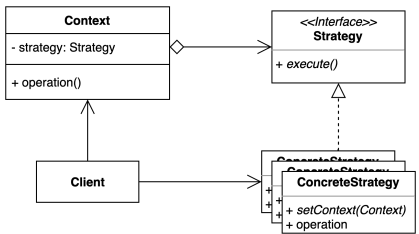
전략 (Strategy) 패턴 구현 방법
기존
- BlueLightRedLight.class
public class BlueLightRedLight {
private int speed;
public BlueLightRedLight(int speed) {
this.speed = speed;
}
public void blueLight() {
if (speed == 1) {
System.out.println("무 궁 화 꽃 이");
} else if (speed == 2) {
System.out.println("무궁화꽃이");
} else {
System.out.println("무광꼬치");
}
}
public void redLight() {
if (speed == 1) {
System.out.println("피 었 습 니 다.");
} else if (speed == 2) {
System.out.println("피었습니다.");
} else {
System.out.println("피어씀다");
}
}
}
- Client.class
public class Client {
public static void main(String[] args) {
BlueLightRedLight blueLightRedLight = new BlueLightRedLight(3);
blueLightRedLight.blueLight();
blueLightRedLight.redLight();
}
}
변경
- Speed.class
public interface Speed {
void blueLight();
void redLight();
}
- Normal.class
public class Normal implements Speed {
@Override
public void blueLight() {
System.out.println("무 궁 화 꽃 이");
}
@Override
public void redLight() {
System.out.println("피 었 습 니 다.");
}
}
- Faster.class
public class Faster implements Speed {
@Override
public void blueLight() {
System.out.println("무궁화꽃이");
}
@Override
public void redLight() {
System.out.println("피었습니다.");
}
}
- Fastest.class
public class Fastest implements Speed{
@Override
public void blueLight() {
System.out.println("무광꼬치");
}
@Override
public void redLight() {
System.out.println("피어씀다.");
}
}
- BlueLightRedLight.class
public class BlueLightRedLight {
public void blueLight(Speed speed) {
speed.blueLight();
}
public void redLight(Speed speed) {
speed.redLight();
}
}
- Client.class
public class Client {
public static void main(String[] args) {
BlueLightRedLight game = new BlueLightRedLight();
game.blueLight(new Normal());
game.redLight(new Fastest());
game.blueLight(new Speed() {
@Override
public void blueLight() {
System.out.println("blue light");
}
@Override
public void redLight() {
System.out.println("red light");
}
});
}
}
전략 (Strategy) 패턴 구현 복습
- 장점
- 새로운 전략을 추가하더라도 기존 코드를 변경하지 않는다.
- 상속 대신 위임을 사용할 수 있다,
- 런타임에 전략을 변경할 수 있다.
- 단점
- 복잡도가 증가한다.
- 클라이언트 코드가 구체적인 전략을 알아야한다.
실무에서 어떻게 쓰이나?
- 자바
- Comparator
public class StrategyInJava {
public static void main(String[] args) {
List<Integer> numbers = new ArrayList<>();
numbers.add(10);
numbers.add(5);
System.out.println(numbers);
Collections.sort(numbers, Comparator.naturalOrder());
System.out.println(numbers);
}
}
- 스프링
- ApplicationContext
- PlatformTransactionManager
- 등등, 너무 많다.
public class StrategyInSpring {
public static void main(String[] args) {
ApplicationContext applicationContext = new ClassPathXmlApplicationContext();
ApplicationContext applicationContext1 = new FileSystemXmlApplicationContext();
ApplicationContext applicationContext2 = new AnnotationConfigApplicationContext();
BeanDefinitionParser parser;
PlatformTransactionManager platformTransactionManager;
CacheManager cacheManager;
}
}
템플릿 메소드 (Template method) 패턴
알고리듬 구조를 서브 클래스가 확장할 수 있도록 템플릿으로 제공하는 방법.
- 추상 클래스는 템플릿을 제공하고 하위 클래스는 구체적인 알골리듬을 제공한다.
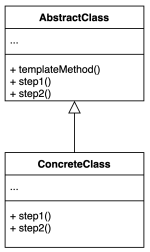
템플릿 콜백 (Template-Callback) 패턴
콜백으로 상속 대신 위임을 사용하는 템플릿 패턴
- 상속 대신 익명 내부 클래스 또는 람다 표현식을 활용할 수 있다.
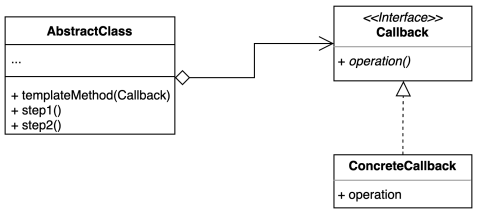
템플릿 메소드 (Template method) 패턴 구현 방법
기존
- FileProcessor.class
public class FileProcessor {
private String path;
public FileProcessor(String path) {
this.path = path;
}
public int process() {
try(BufferedReader reader = new BufferedReader(new FileReader(path))) {
int result = 0;
String line = null;
while((line = reader.readLine()) != null) {
result += Integer.parseInt(line);
}
return result;
} catch (IOException e) {
throw new IllegalArgumentException(path + "에 해당하는 파일이 없습니다.", e);
}
}
}
- MultuplyFileProcessor.class
public class MultuplyFileProcessor {
private String path;
public MultuplyFileProcessor(String path) {
this.path = path;
}
public int process() {
try(BufferedReader reader = new BufferedReader(new FileReader(path))) {
int result = 0;
String line = null;
while((line = reader.readLine()) != null) {
result *= Integer.parseInt(line);
}
return result;
} catch (IOException e) {
throw new IllegalArgumentException(path + "에 해당하는 파일이 없습니다.", e);
}
}
}
- Client.class
public class Client {
public static void main(String[] args) {
FileProcessor fileProcessor = new FileProcessor("number.txt");
int result = fileProcessor.process();
System.out.println(result);
}
}
변경
템플릿 메서드 패턴
- FileProcessor.class
public abstract class FileProcessor {
private String path;
public FileProcessor(String path) {
this.path = path;
}
public int process() {
try(BufferedReader reader = new BufferedReader(new FileReader(path))) {
int result = 0;
String line = null;
while((line = reader.readLine()) != null) {
result = getResult(result, Integer.parseInt(line));
}
return result;
} catch (IOException e) {
throw new IllegalArgumentException(path + "에 해당하는 파일이 없습니다.", e);
}
}
protected abstract int getResult(int result, int number);
}
- Multiply.class
public class Multiply extends FileProcessor {
public Multiply(String path) {
super(path);
}
@Override
protected int getResult(int result, int number) {
return result *= number;
}
}
템플릿 콜백 패턴
- Operator.class
public interface Operator {
abstract int getResult(int result, int number);
}
- FileProcessor.class
public class FileProcessor {
private String path;
public FileProcessor(String path) {
this.path = path;
}
public final int process(Operator operator) {
try(BufferedReader reader = new BufferedReader(new FileReader(path))) {
int result = 0;
String line = null;
while((line = reader.readLine()) != null) {
result = operator.getResult(result, Integer.parseInt(line));
}
return result;
} catch (IOException e) {
throw new IllegalArgumentException(path + "에 해당하는 파일이 없습니다.", e);
}
}
}
- Plus.class
public class Plus implements Operator {
@Override
public int getResult(int result, int number) {
return result += number;
}
}
- Client.class
public class Client {
public static void main(String[] args) {
FileProcessor fileProcessor = new Multiply("number.txt");
int result = fileProcessor.process((sum, number) -> sum += number);
System.out.println(result);
}
}
템플릿 메소드 (Template method) 패턴 구현 복습
- 장점
- 템플릿 코드를 재사용하고 중복 코드를 줄일 수 있다.
- 템플릿 코드를 변경하지 않고 상속을 받아서 구체적인 알고리듬만 변경할 수 있다.
- 단점
- 리스코프 치환 원칙을 위반할 수도 있다.
- 알고리듬 구조가 복잡할 수록 템플릿을 유지하기 어려워진다.
실무에서 어떻게 쓰이나?
- 자바
- HttpServlet
public class MyHello extends HttpServlet {
@Override
protected void doGet(HttpServletRequest req, HttpServletResponse resp) throws ServletException, IOException {
super.doGet(req, resp);
}
@Override
protected void doPost(HttpServletRequest req, HttpServletResponse resp) throws ServletException, IOException {
super.doPost(req, resp);
}
}
- 스프링
- 템플릿 메소드 패턴
- Configuration
- 템플릿 콜백 패턴
- JdbcTemplate
- RestTemplate
- 등등
- 템플릿 메소드 패턴
public class TemplateInSpring {
public static void main(String[] args) {
// TODO 템플릿-콜백 패턴
// JdbcTemplate
JdbcTemplate jdbcTemplate = new JdbcTemplate();
jdbcTemplate.execute("insert");
// RestTemplate
RestTemplate restTemplate = new RestTemplate();
HttpHeaders headers = new HttpHeaders();
headers.setAccept(Arrays.asList(MediaType.APPLICATION_JSON));
headers.set("X-COM-PERSIST", "NO");
headers.set("X-COM-LOCATION", "USA");
HttpEntity<String> entity = new HttpEntity<String>(headers);
ResponseEntity<String> responseEntity = restTemplate
.exchange("http://localhost:8080/users", HttpMethod.GET, entity, String.class);
}
@Configuration
class SecurityConfig extends WebSecurityConfigurerAdapter {
@Override
protected void configure(HttpSecurity http) throws Exception {
http.authorizeRequests().anyRequest().permitAll();
}
}
}
방문자 (Visitor) 패턴
기존 코드를 변경하지 않고 새로운 기능을 추가하는 방법
- 더블 디스패치 (Double Dispatch)를 활용할 수 있다.
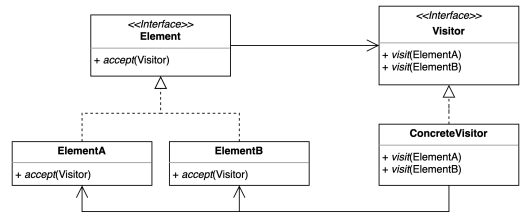
방문자 (Visitor) 패턴 구현 방법
기존
- Device.class
public interface Device {
}
- Phone.class
public class Phone implements Device{
}
- Watch.class
public class Watch implements Device{
}
- Shape.class
public interface Shape {
void printTo(Device device);
}
- Triangle.class
public class Triangle implements Shape {
@Override
public void printTo(Device device) {
if (device instanceof Phone) {
System.out.println("print Triangle to Phone");
} else if (device instanceof Watch) {
System.out.println("print Triangle to Watch");
}
}
}
- Circle.class
public class Circle implements Shape {
@Override
public void printTo(Device device) {
if (device instanceof Phone) {
System.out.println("print Circle to phone");
} else if (device instanceof Watch) {
System.out.println("print Circle to watch");
}
}
}
- Client.class
public class Client {
public static void main(String[] args) {
Shape rectangle = new Rectangle();
Device device = new Phone();
rectangle.printTo(device);
}
}
변경
- Device.class
public interface Device {
void print(Circle circle);
void print(Rectangle rectangle);
void print(Triangle triangle);
}
- Pad.class
public class Pad implements Device {
@Override
public void print(Circle circle) {
System.out.println("Print Circle to Pad");
}
@Override
public void print(Rectangle rectangle) {
System.out.println("Print Rectangle to Pad");
}
@Override
public void print(Triangle triangle) {
System.out.println("Print Triangle to Pad");
}
}
- Phone.class
public class Phone implements Device {
@Override
public void print(Circle circle) {
System.out.println("Print Circle to Phone");
}
@Override
public void print(Rectangle rectangle) {
System.out.println("Print Rectangle to Phone");
}
@Override
public void print(Triangle triangle) {
System.out.println("Print Triangle to Phone");
}
}
- Watch.class
public class Watch implements Device {
@Override
public void print(Circle circle) {
System.out.println("Print Circle to Watch");
}
@Override
public void print(Rectangle rectangle) {
System.out.println("Print Rectangle to Watch");
}
@Override
public void print(Triangle triangle) {
System.out.println("Print Triangle to Watch");
}
}
- Shape.class
public interface Shape {
void accept(Device device);
}
- Circle.class
public class Circle implements Shape {
@Override
public void accept(Device device) {
device.print(this);
}
}
- Triangle.class
public class Triangle implements Shape {
@Override
public void accept(Device device) {
device.print(this);
}
}
- Rectangle.class
public class Rectangle implements Shape {
@Override
public void accept(Device device) {
device.print(this);
}
}
- Client.class
public class Client {
public static void main(String[] args) {
Shape rectangle = new Rectangle();
Device device = new Pad();
rectangle.accept(device);
}
}
방문자 (Visitor) 패턴 구현 복습
- 장점
- 기존 코드를 변경하지 않고 새로운 코드를 추가할 수 있다.
- 추가 기능을 한 곳에 모아둘 수 있다.
- 단점
- 복잡하다.
- 새로운 Element를 추가하거나 제거할 때 모든 Visitor 코드를 변경해야 한다.
실무에서 어떻게 쓰이나?
- 자바
- FileVisitor, SimpleFileVisitor
- AnnotationValueVisitor
- ElementVisitor
public class SearchFileVisitor implements FileVisitor<Path> {
private String fileToSearch;
private Path startingDirectory;
public SearchFileVisitor(String fileToSearch, Path startingDirectory) {
this.fileToSearch = fileToSearch;
this.startingDirectory = startingDirectory;
}
@Override
public FileVisitResult preVisitDirectory(Path dir, BasicFileAttributes attrs) throws IOException {
return FileVisitResult.CONTINUE;
}
@Override
public FileVisitResult visitFile(Path file, BasicFileAttributes attrs) throws IOException {
if (fileToSearch.equals(file.getFileName().toString())) {
System.out.println("found " + file.getFileName());
return FileVisitResult.TERMINATE;
}
return FileVisitResult.CONTINUE;
}
@Override
public FileVisitResult visitFileFailed(Path file, IOException exc) throws IOException {
exc.printStackTrace(System.out);
return FileVisitResult.CONTINUE;
}
@Override
public FileVisitResult postVisitDirectory(Path dir, IOException exc) throws IOException {
if (Files.isSameFile(startingDirectory, dir)) {
System.out.println("search end");
return FileVisitResult.TERMINATE;
}
return FileVisitResult.CONTINUE;
}
}
public class VisitorInJava {
public static void main(String[] args) throws IOException {
Path startingDirectory = Path.of("/Users/test/workspace/design-patterns");
SearchFileVisitor searchFileVisitor =
new SearchFileVisitor("Triangle.java", startingDirectory);
Files.walkFileTree(startingDirectory, searchFileVisitor);
}
}
- 스프링
- BeanDefinitionVisitor
public class VisitorInSpring {
public static void main(String[] args) {
BeanDefinitionVisitor beanDefinitionVisitor;
}
}
